James Kwok
HKUST
Alignment of Diffusion Models: Fundamentals, Challenges, and Future
Sep 12, 2024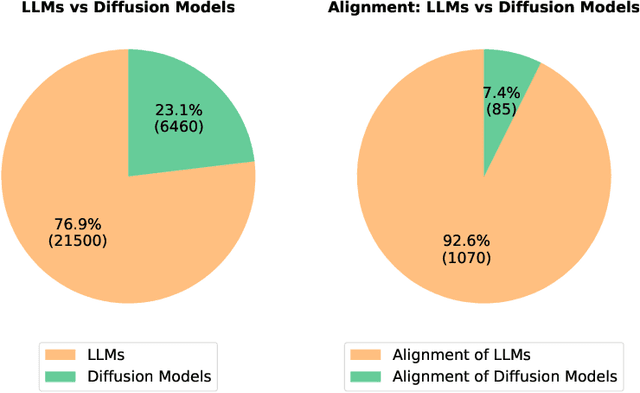
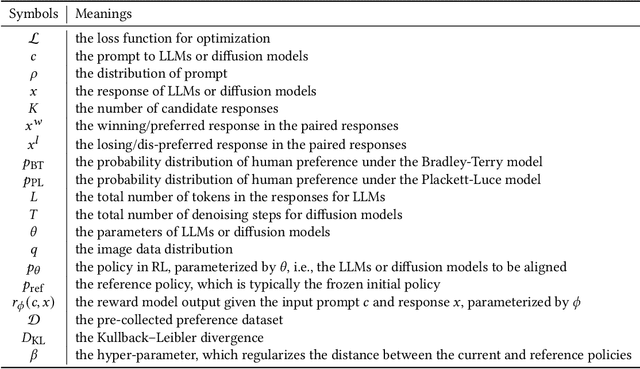
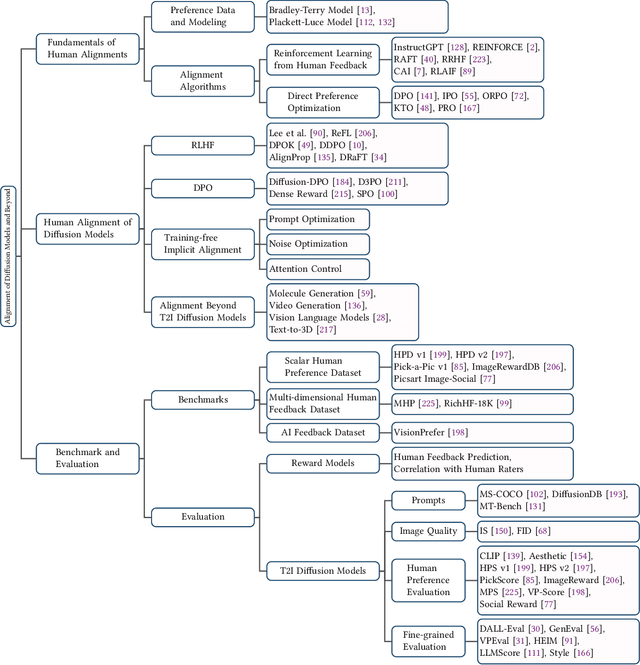
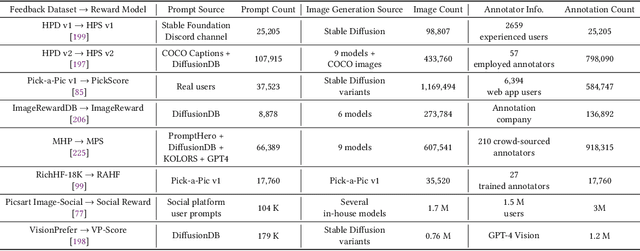
Abstract:Diffusion models have emerged as the leading paradigm in generative modeling, excelling in various applications. Despite their success, these models often misalign with human intentions, generating outputs that may not match text prompts or possess desired properties. Inspired by the success of alignment in tuning large language models, recent studies have investigated aligning diffusion models with human expectations and preferences. This work mainly reviews alignment of diffusion models, covering advancements in fundamentals of alignment, alignment techniques of diffusion models, preference benchmarks, and evaluation for diffusion models. Moreover, we discuss key perspectives on current challenges and promising future directions on solving the remaining challenges in alignment of diffusion models. To the best of our knowledge, our work is the first comprehensive review paper for researchers and engineers to comprehend, practice, and research alignment of diffusion models.
CodeGraph: Enhancing Graph Reasoning of LLMs with Code
Aug 25, 2024Abstract:With the increasing popularity of large language models (LLMs), reasoning on basic graph algorithm problems is an essential intermediate step in assessing their abilities to process and infer complex graph reasoning tasks. Existing methods usually convert graph-structured data to textual descriptions and then use LLMs for reasoning and computation. However, LLMs often produce computation errors on arithmetic parts in basic graph algorithm problems, such as counting number of edges. In addition, they struggle to control or understand the output of the reasoning process, raising concerns about whether LLMs are simply guessing. In this paper, we introduce CodeGraph, a method that encodes graph problem solutions as code. The methods solve new graph problems by learning from exemplars, generating programs, and executing them via a program interpreter. Using the few-shot setting, we evaluate CodeGraph with the base LLM being GPT-3.5 Turbo, Llama3-70B Instruct, Mixtral-8x22B Instruct, and Mixtral-8x7B Instruct. Experimental results on six tasks with six graph encoding methods in the GraphQA dataset demonstrate that CodeGraph can boost performance on graph reasoning tasks inside LLMs by 1.3% to 58.6%, depending on the task. Compared to the existing methods, CodeGraph demonstrates strong performance on arithmetic problems in graph tasks and offers a more controllable and interpretable approach to the reasoning process.
You Only Merge Once: Learning the Pareto Set of Preference-Aware Model Merging
Aug 22, 2024Abstract:Model merging, which combines multiple models into a single model, has gained increasing popularity in recent years. By efficiently integrating the capabilities of various models without their original training data, this significantly reduces the parameter count and memory usage. However, current methods can only produce one single merged model. This necessitates a performance trade-off due to conflicts among the various models, and the resultant one-size-fits-all model may not align with the preferences of different users who may prioritize certain models over others. To address this issue, we propose preference-aware model merging, and formulate this as a multi-objective optimization problem in which the performance of the merged model on each base model's task is treated as an objective. In only one merging process, the proposed parameter-efficient structure can generate the whole Pareto set of merged models, each representing the Pareto-optimal model for a given user-specified preference. Merged models can also be selected from the learned Pareto set that are tailored to different user preferences. Experimental results on a number of benchmark datasets demonstrate that the proposed preference-aware Pareto Merging can obtain a diverse set of trade-off models and outperforms state-of-the-art model merging baselines.
Knowledge-Aware Parsimony Learning: A Perspective from Relational Graphs
Jun 29, 2024Abstract:The scaling law, a strategy that involves the brute-force scaling of the training dataset and learnable parameters, has become a prevalent approach for developing stronger learning models. In this paper, we examine its rationale in terms of learning from relational graphs. We demonstrate that directly adhering to such a scaling law does not necessarily yield stronger models due to architectural incompatibility and representation bottlenecks. To tackle this challenge, we propose a novel framework for learning from relational graphs via knowledge-aware parsimony learning. Our method draws inspiration from the duality between data and knowledge inherent in these graphs. Specifically, we first extract knowledge (like symbolic logic and physical laws) during the learning process, and then apply combinatorial generalization to the task at hand. This extracted knowledge serves as the ``building blocks'' for achieving parsimony learning. By applying this philosophy to architecture, parameters, and inference, we can effectively achieve versatile, sample-efficient, and interpretable learning. Experimental results show that our proposed framework surpasses methods that strictly follow the traditional scaling-up roadmap. This highlights the importance of incorporating knowledge in the development of next-generation learning technologies.
Nonparametric Teaching for Multiple Learners
Nov 17, 2023Abstract:We study the problem of teaching multiple learners simultaneously in the nonparametric iterative teaching setting, where the teacher iteratively provides examples to the learner for accelerating the acquisition of a target concept. This problem is motivated by the gap between current single-learner teaching setting and the real-world scenario of human instruction where a teacher typically imparts knowledge to multiple students. Under the new problem formulation, we introduce a novel framework -- Multi-learner Nonparametric Teaching (MINT). In MINT, the teacher aims to instruct multiple learners, with each learner focusing on learning a scalar-valued target model. To achieve this, we frame the problem as teaching a vector-valued target model and extend the target model space from a scalar-valued reproducing kernel Hilbert space used in single-learner scenarios to a vector-valued space. Furthermore, we demonstrate that MINT offers significant teaching speed-up over repeated single-learner teaching, particularly when the multiple learners can communicate with each other. Lastly, we conduct extensive experiments to validate the practicality and efficiency of MINT.
Positive-Unlabeled Node Classification with Structure-aware Graph Learning
Oct 20, 2023Abstract:Node classification on graphs is an important research problem with many applications. Real-world graph data sets may not be balanced and accurate as assumed by most existing works. A challenging setting is positive-unlabeled (PU) node classification, where labeled nodes are restricted to positive nodes. It has diverse applications, e.g., pandemic prediction or network anomaly detection. Existing works on PU node classification overlook information in the graph structure, which can be critical. In this paper, we propose to better utilize graph structure for PU node classification. We first propose a distance-aware PU loss that uses homophily in graphs to introduce more accurate supervision. We also propose a regularizer to align the model with graph structure. Theoretical analysis shows that minimizing the proposed loss also leads to minimizing the expected loss with both positive and negative labels. Extensive empirical evaluation on diverse graph data sets demonstrates its superior performance over existing state-of-the-art methods.
PixArt-$α$: Fast Training of Diffusion Transformer for Photorealistic Text-to-Image Synthesis
Oct 16, 2023



Abstract:The most advanced text-to-image (T2I) models require significant training costs (e.g., millions of GPU hours), seriously hindering the fundamental innovation for the AIGC community while increasing CO2 emissions. This paper introduces PIXART-$\alpha$, a Transformer-based T2I diffusion model whose image generation quality is competitive with state-of-the-art image generators (e.g., Imagen, SDXL, and even Midjourney), reaching near-commercial application standards. Additionally, it supports high-resolution image synthesis up to 1024px resolution with low training cost, as shown in Figure 1 and 2. To achieve this goal, three core designs are proposed: (1) Training strategy decomposition: We devise three distinct training steps that separately optimize pixel dependency, text-image alignment, and image aesthetic quality; (2) Efficient T2I Transformer: We incorporate cross-attention modules into Diffusion Transformer (DiT) to inject text conditions and streamline the computation-intensive class-condition branch; (3) High-informative data: We emphasize the significance of concept density in text-image pairs and leverage a large Vision-Language model to auto-label dense pseudo-captions to assist text-image alignment learning. As a result, PIXART-$\alpha$'s training speed markedly surpasses existing large-scale T2I models, e.g., PIXART-$\alpha$ only takes 10.8% of Stable Diffusion v1.5's training time (675 vs. 6,250 A100 GPU days), saving nearly \$300,000 (\$26,000 vs. \$320,000) and reducing 90% CO2 emissions. Moreover, compared with a larger SOTA model, RAPHAEL, our training cost is merely 1%. Extensive experiments demonstrate that PIXART-$\alpha$ excels in image quality, artistry, and semantic control. We hope PIXART-$\alpha$ will provide new insights to the AIGC community and startups to accelerate building their own high-quality yet low-cost generative models from scratch.
Geom-Erasing: Geometry-Driven Removal of Implicit Concept in Diffusion Models
Oct 13, 2023Abstract:Fine-tuning diffusion models through personalized datasets is an acknowledged method for improving generation quality across downstream tasks, which, however, often inadvertently generates unintended concepts such as watermarks and QR codes, attributed to the limitations in image sources and collecting methods within specific downstream tasks. Existing solutions suffer from eliminating these unintentionally learned implicit concepts, primarily due to the dependency on the model's ability to recognize concepts that it actually cannot discern. In this work, we introduce Geom-Erasing, a novel approach that successfully removes the implicit concepts with either an additional accessible classifier or detector model to encode geometric information of these concepts into text domain. Moreover, we propose Implicit Concept, a novel image-text dataset imbued with three implicit concepts (i.e., watermarks, QR codes, and text) for training and evaluation. Experimental results demonstrate that Geom-Erasing not only identifies but also proficiently eradicates implicit concepts, revealing a significant improvement over the existing methods. The integration of geometric information marks a substantial progression in the precise removal of implicit concepts in diffusion models.
GrowCLIP: Data-aware Automatic Model Growing for Large-scale Contrastive Language-Image Pre-training
Aug 22, 2023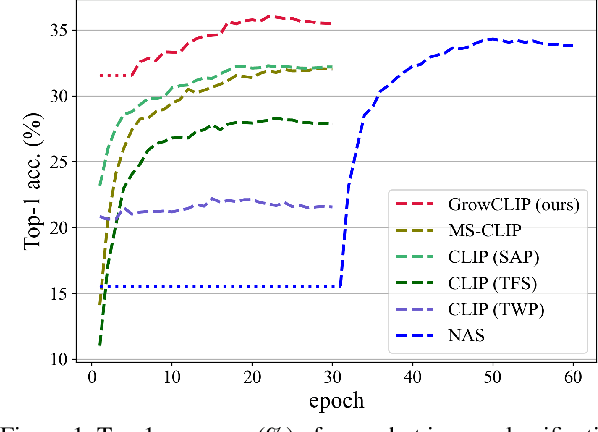

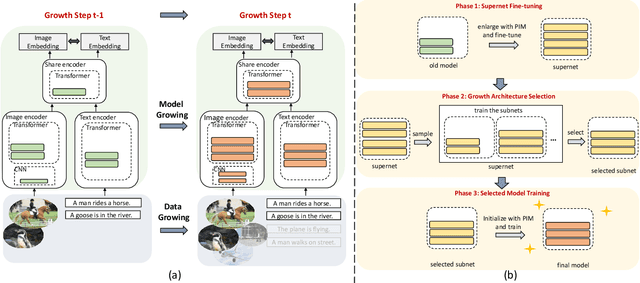

Abstract:Cross-modal pre-training has shown impressive performance on a wide range of downstream tasks, benefiting from massive image-text pairs collected from the Internet. In practice, online data are growing constantly, highlighting the importance of the ability of pre-trained model to learn from data that is continuously growing. Existing works on cross-modal pre-training mainly focus on training a network with fixed architecture. However, it is impractical to limit the model capacity when considering the continuously growing nature of pre-training data in real-world applications. On the other hand, it is important to utilize the knowledge in the current model to obtain efficient training and better performance. To address the above issues, in this paper, we propose GrowCLIP, a data-driven automatic model growing algorithm for contrastive language-image pre-training with continuous image-text pairs as input. Specially, we adopt a dynamic growth space and seek out the optimal architecture at each growth step to adapt to online learning scenarios. And the shared encoder is proposed in our growth space to enhance the degree of cross-modal fusion. Besides, we explore the effect of growth in different dimensions, which could provide future references for the design of cross-modal model architecture. Finally, we employ parameter inheriting with momentum (PIM) to maintain the previous knowledge and address the issue of the local minimum dilemma. Compared with the existing methods, GrowCLIP improves 2.3% average top-1 accuracy on zero-shot image classification of 9 downstream tasks. As for zero-shot image retrieval, GrowCLIP can improve 1.2% for top-1 image-to-text recall on Flickr30K dataset.
Non-autoregressive Conditional Diffusion Models for Time Series Prediction
Jun 08, 2023



Abstract:Recently, denoising diffusion models have led to significant breakthroughs in the generation of images, audio and text. However, it is still an open question on how to adapt their strong modeling ability to model time series. In this paper, we propose TimeDiff, a non-autoregressive diffusion model that achieves high-quality time series prediction with the introduction of two novel conditioning mechanisms: future mixup and autoregressive initialization. Similar to teacher forcing, future mixup allows parts of the ground-truth future predictions for conditioning, while autoregressive initialization helps better initialize the model with basic time series patterns such as short-term trends. Extensive experiments are performed on nine real-world datasets. Results show that TimeDiff consistently outperforms existing time series diffusion models, and also achieves the best overall performance across a variety of the existing strong baselines (including transformers and FiLM).
 Add to Chrome
Add to Chrome Add to Firefox
Add to Firefox Add to Edge
Add to Edge